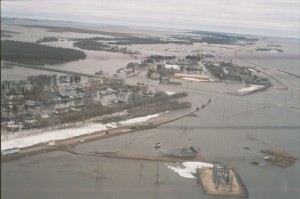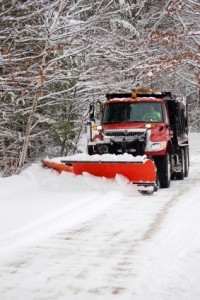
On this page, you will see how climate change will affect
Click a link in the list above to jump to that topic on this page.
Climate change will affect different communities in different ways.
According to the Federation of Canadian Municipalities,
“up to half of Canada’s greenhouse gas (GHG) emissions (350 million tonnes) are under the direct or indirect control or influence of municipal governments.” (1)
By taking pro-active steps to becoming a climate-friendly community you may be able to avoid or minimize some of the negative consequences being predicted for communities. Climate change can mean positive changes to the way we live in our communities.
 Rural communities
Rural communities
Rural communities face many changes due to the potential impacts on agriculture (1) There will also be changes to
Rural society
Social impacts vary but “human systems, such as welfare, social aid and medical systems, are likely to be affected by climate change.” (2). Climate change will change the way people live, work, worship and play in their built and natural environments.
Some examples of the social impacts of climate change include:
- a loss of culture – “Climate change will have physical, social and cultural impacts on cultural heritage.” (3) For example, archeological evidence, historical buildings, monuments, and other heritage sites will be directly affected by changes in weather patterns and indirectly by society’s changing values.
- a loss of employment – Although loss of employment may be considered an economic impact of climate change, unemployment, particularly in resource based communities such as forestry and fishing, can affect all aspects of community life. On a personal level, unemployment can increase family stress and on a community level, recreation programs may suffer as families leave the community in search of employment elsewhere.
Community policy
“The primary task of municipal leaders is to care for their own citizens.” (4) Climate change is affecting municipal policy because it is public institutions who decide on “land-use planning (allowing or avoiding building in areas with a high risk exposure), adopting construction codes (to reduce the impact and costs of extreme weather) and are responsible for the investments in general prevention measures like coastal defences and river embankments.” (5)
Some potential ways that climate change will affect public policy in rural areas include
- Decision makers will need to become as informed as possible about climate change – a topic that may not have been at the forefront of many past decisions. Specifically, “there is a need for more communication (information sharing and training) between climate change researchers, policy makers, engineers, architects, operators or asset managers in order to mainstream climate change adaptation into design, maintenance and restoration of infrastructure.” (6)
- Policies and programs will need to shift from what have been labeled mitigation to ones of adaptation. An example of a mitigation strategy is a program that aims to reduce further greenhouse gas emissions, such as the Climate Change Connection’s “Healthy Communities Don’t Idle” program. While mitigation programs continue to play an important role, rural communities also need to develop strategies and policies for how they will adapt to the changing climate.
 Northern communities
Northern communities
“In Canada, Aboriginal communities are likely to be among the hardest hit by the effects of global climate change because of geography, connectedness to the land and limited resources to adapt to changing conditions” (1).
It is important to note that these communities have been experiencing the effects of global warming for over a decade now. Traditional ways, transportation methods, infrastructure, safety, and drainage are all being affected.
It has also been identified that many health problems like mold in houses, safe and clean drinking water, and respiratory problems, could be worsened by the effects of climate change.
In Hudson’s Bay, an extension of the ice-free season could threaten seals and their main predators, polar bears. Longer ice-free seasons will make hunting and trapping more difficult and dangerous. On the positive side, the increased ice-free season will create an opportunity to extend the shipping season at the port of Churchill.
A change in climate will also result in the appearance of new species of insects, fish, and mammals.
Permafrost
Permafrost is ground that is permanently frozen. It provides the foundation for the northern forests, roads, railways, airstrips, and houses. Permafrost is extremely sensitive to rises in temperature. While snow and ice reflects much of the Sun’s energy back into the atmosphere, permafrost absorbs most of it.
The permanency of this layer of earth is no longer dependable. With climate warming, permafrost is thawing and may ultimately disappear. The thawing of permafrost causes extensive disruption to existing roads, railways, airport infrastructures, and houses. These vital links are critical to the health and welfare of northern Manitoban residents.
Another significant concern facing us today is the potential climate effect of large scale melting of permafrost. The thawing of permafrost has the potential to release significant amounts of methane into the atmosphere.
 Winter roads
Winter roads
Winter roads are roads created across frozen ground, lakes, or rivers. They provide an important role in northern transportation, both for community supplies (food, fuel, medical supplies, building materials) and access to other communities. In some cases, they are the only way families are connected.
Northern Manitobans in nine eastern and sixteen northern Manitoba communities are served by these roads during a brief period of about eight weeks from mid-January to early March. Weather conditions can shorten or extend this period by as much as two weeks. Over the past decade the period of time during which winter roads are available has shortened dramatically. What was once a season of 50 – 60 days has been as low as 20 days.
Every year, the Manitoba Department of Highways builds enough winter roads to stretch from Winnipeg to Vancouver.
Warmer winters, due to climate change, will reduce the length of time winter roads can be used, affecting access to and from remote communities and increasing the need to fly-in supplies. Reduction in the winter road season causes shortages of food, fuel and medical supplies in the communities. This results in higher living costs and potential decreases in quality of life and health.
Reduced winter road seasons also perpetuate feelings of isolation and impacts social and mental health in northern communities. Climate change will also affect the travel safety on these roads. Every year in Manitoba, individuals die because their vehicles fall through the ice.
A shorter ice-road season may be partially offset by a longer open-water or ice-free season. However, this is only beneficial to the communities with water access and adequate shore infrastructure.
For more details on winter roads in Manitoba, click here.
 Urban communities
Urban communities
In Canada, roughly 60% of the population lives in urban areas of 100,000 people or more and about 80% in urban areas of 10,000 or more. (1) In Manitoba, about 60% of the population lives in metro Winnipeg.
Some of the potential impacts on prairie cities include (2)
- longer summer recreational season
- shorter winter season
- increased heat stress
- decreased air quality
- increased demand for air conditioning
- reduced winter heating demand
- decreased need for snow removal
- invasion of new insects and diseases
Given all these potential impacts, almost all city departments will be affected by climate change (3) including
- transportation
- parks and recreation
- water and sewage
- energy use
- garbage collection
- snow and ice control
- pest control
- horticulture
- human safety
- construction and building codes
- hazards (blizzards, wind storms, cold and hot spells, fires)
Infrastructure impacts
“Cities have become increasingly dependent on their lifelines, including transportation systems (e.g., air, water, road and rail) that move people and goods; water and electric power supply systems; and sewers and waste removal systems. All of these elements have become essential in the modern city, making them points of vulnerability.” (4)“Due to climate change Canada’s infrastructure is increasingly forced to withstand more frequent and extreme weather events, more climate variability, and changes in climate norms.” (5)
Some examples of the impact of climate change on urban infrastructure include (6):
- Asphalt, concrete and other hard surfaces in the city absorb radiation from the sun, causing the urban heat island effect, which exacerbates heat waves and puts pressure on electricity generation and distribution systems.
- Combined sewers that carry both stormwater and sewage are common in many city centres. Protracted or intense precipitation leads to overflows in these sewer systems, washing untreated pollutants into local water bodies.
- Centralized power sources, longer distribution lines, and an increasingly interconnected grid increases vulnerability to blackouts when electricity demands are high – during heat waves, for example – and when storms occur. The impact of blackouts has also grown as homes and businesses have become more dependent on electronic control and communication systems.
Economic impacts
Globally, it is estimated that the overall costs of climate change will be equivalent to losing at least 5% of global GDP each year.
According to these estimates, as the climate changes the increase in extreme weather events may double in annual costs in the coming decades and account for 10% to 20% of the total economic impact of climate change. (7)
From an urban perspective many of these economic costs will incur in our cities. “The Canadian economy is inextricably linked to the health of its cities; for example, the seven largest cities in Canada generate almost 45% of the national GDP and large cities like Vancouver and Montreal account for over half of provincial GDP.” (8)
Some examples of the economic impacts of climate change include:
- challenges to the insurance industry. “Insurance is on the front line of climate change” (9) as it is often the insurers who are responsible for putting the pieces back together after extreme weather events or in assisting businesses and farmers when longer term weather patterns affect their bottom-lines.
- positive economic changes. “The world does not need to choose between averting climate change and promoting…Action on climate change will also create significant business opportunities, as new markets are created in low-carbon energy technologies and other low-carbon goods and services. These markets could grow to be worth hundreds of billions of dollars each year, and employment in these sectors will expand accordingly.” (10)




